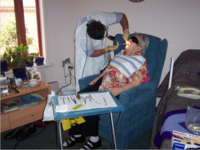
Photo from wikipedia
Objective This is the second part of a report on tooth loss in Germany 1997–2030. Here, we describe trends in the prevalence of edentulism in seniors 1997–2014, assess predictive factors… Click to show full abstract
Objective This is the second part of a report on tooth loss in Germany 1997–2030. Here, we describe trends in the prevalence of edentulism in seniors 1997–2014, assess predictive factors for edentulism, and projected it into 2030. Material and methods We used data from three waves of the cross-sectional, multi-center, nationwide representative German Oral Health Studies. Overall, 3449 seniors (65–74 years) were included (1997: 1367; 2005: 1040; 2016: 1042). Age, sex, educational level, smoking status, and the cohort were entered into age-cohort binary-logistic regression models to assess the association of predictors with edentulism and to project edentulism in 2030 via Monte Carlo simulations. Results Between 1997 and 2014, the prevalence of edentulism decreased from 24.8 to 12.4%. With each year of age, the risk of being edentate increased (by 11%, p < 0.001); it was also significantly increased in female versus male (by 40%, p = 0.001), low versus medium and high educational level (up to 257%, p < 0.001), and in former and current smokers (up to 258%, p < 0.001). We predict the prevalence of edentulism to be reduced to 4.2% in 2030. The reduction will be higher in males, never and former smokers, and those with low socio-educational level. On an absolute level and despite a growing elderly population (aged 60–80 years), the number of edentate individuals will have decreased by 3.6 million in 2030 compared with 1997. Conclusions Edentulism in seniors has declined equitably in Germany. The decline is expected to continue until 2030. Further efforts are needed to tackle the underlying risk factors. Clinical relevance This study presents trends of edentulism in Germany for a period of three decades. It provides clinically relevant data for health care planning by 2030.
Journal Title: Clinical Oral Investigations
Year Published: 2020
Link to full text (if available)
Share on Social Media: Sign Up to like & get
recommendations!